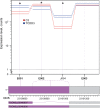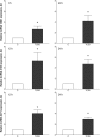Identification and characterization of long non-coding RNAs in porcine granulosa cells exposed to 2,3,7,8-tetrachlorodibenzo- p-dioxin
- PMID: 30338064
- PMCID: PMC6180664
- DOI: 10.1186/s40104-018-0288-3
Identification and characterization of long non-coding RNAs in porcine granulosa cells exposed to 2,3,7,8-tetrachlorodibenzo- p-dioxin
Abstract
Background: Long non-coding RNAs (lncRNAs) may regulate gene expression in numerous biological processes including cellular response to xenobiotics. The exposure of living organisms to 2,3,7,8-tetrachlorodibenzo-p-dioxin (TCDD), a persistent environmental contaminant, results in reproductive defects in many species including pigs. The aims of the study were to identify and characterize lncRNAs in porcine granulosa cells as well as to examine the effects of TCDD on the lncRNA expression profile in the cells.
Results: One thousand six hundred sixty-six lncRNAs were identified and characterized in porcine granulosa cells. The identified lncRNAs were found to be shorter than mRNAs. In addition, the number of exons was lower in lncRNAs than in mRNAs and their exons were longer. TCDD affected the expression of 22 lncRNAs (differentially expressed lncRNAs [DELs]; log2 fold change ≥ 1, P-adjusted < 0.05) in the examined cells. Potential functions of DELs were indirectly predicted via searching their target cis- and trans-regulated protein-coding genes. The co-expression analysis revealed that DELs may influence the expression of numerous genes, including those involved in cellular response to xenobiotics, dioxin metabolism, endoplasmic reticulum stress and cell proliferation. Aryl hydrocarbon receptor (AhR) and cytochrome P450 1A1 (CYP1A1) were found among the trans-regulated genes.
Conclusions: These findings indicate that the identified lncRNAs may constitute a part of the regulatory mechanism of TCDD action in granulosa cells. To our knowledge, this is the first study describing lncRNAs in porcine granulosa cells as well as TCDD effects on the lncRNA expression profile. These results may trigger new research directions leading to better understanding of molecular processes induced by xenobiotics in the ovary.
Keywords: AVG-16 cell line; Granulosa cells; Pig; RNA-Seq; TCDD; lncRNAs.
Conflict of interest statement
Not applicable.Not applicable.The authors declare that they have no competing interests.
Figures






Similar articles
-
Knock-down of aryl hydrocarbon receptor (AhR) affects the lncRNA-mediated response of porcine granulosa cells (AVG-16 cell line) to 2,3,7,8-tetrachlorodibenzo-p-dioxin (TCDD).Anim Reprod Sci. 2023 Aug;255:107277. doi: 10.1016/j.anireprosci.2023.107277. Epub 2023 Jun 7. Anim Reprod Sci. 2023. PMID: 37315452
-
The effects of 2,3,7,8-tetrachlorodibenzo-p-dioxin (TCDD) on the transcriptome of aryl hydrocarbon receptor (AhR) knock-down porcine granulosa cells.PeerJ. 2020 Jan 22;8:e8371. doi: 10.7717/peerj.8371. eCollection 2020. PeerJ. 2020. PMID: 32002328 Free PMC article.
-
Transcriptional profiling of porcine granulosa cells exposed to 2,3,7,8-tetrachlorodibenzo-p-dioxin.Chemosphere. 2017 Jul;178:368-377. doi: 10.1016/j.chemosphere.2017.03.055. Epub 2017 Mar 16. Chemosphere. 2017. PMID: 28340459
-
Functional role of AhR in the expression of toxic effects by TCDD.Biochim Biophys Acta. 2003 Feb 17;1619(3):263-8. doi: 10.1016/s0304-4165(02)00485-3. Biochim Biophys Acta. 2003. PMID: 12573486 Review.
-
Dioxin: a review of its environmental effects and its aryl hydrocarbon receptor biology.J Comp Physiol B. 2005 May;175(4):221-30. doi: 10.1007/s00360-005-0483-3. Epub 2005 Apr 8. J Comp Physiol B. 2005. PMID: 15900503 Review.
Cited by
-
Genome-Wide Expression Profiling of mRNAs, lncRNAs and circRNAs in Skeletal Muscle of Two Different Pig Breeds.Animals (Basel). 2021 Nov 5;11(11):3169. doi: 10.3390/ani11113169. Animals (Basel). 2021. PMID: 34827901 Free PMC article.
-
Transgenerational Transmission of 2,3,7,8-Tetrachlorodibenzo-p-dioxin (TCDD) Effects in Human Granulosa Cells: The Role of MicroRNAs.Int J Mol Sci. 2024 Jan 17;25(2):1144. doi: 10.3390/ijms25021144. Int J Mol Sci. 2024. PMID: 38256218 Free PMC article.
-
Long non-coding RNAs in ovarian granulosa cells.J Ovarian Res. 2020 Jun 5;13(1):63. doi: 10.1186/s13048-020-00663-2. J Ovarian Res. 2020. PMID: 32503679 Free PMC article. Review.
-
Effect of Lactoferrin on the Expression Profiles of Long Non-coding RNA during Osteogenic Differentiation of Bone Marrow Mesenchymal Stem Cells.Int J Mol Sci. 2019 Sep 28;20(19):4834. doi: 10.3390/ijms20194834. Int J Mol Sci. 2019. PMID: 31569432 Free PMC article.
-
Tamoxifen decreases ovarian toxicity without compromising cancer treatment in a rat model of mammary cancer.BMC Genomics. 2023 Jun 13;24(1):325. doi: 10.1186/s12864-023-09423-0. BMC Genomics. 2023. PMID: 37312040 Free PMC article.
References
LinkOut - more resources
Full Text Sources

